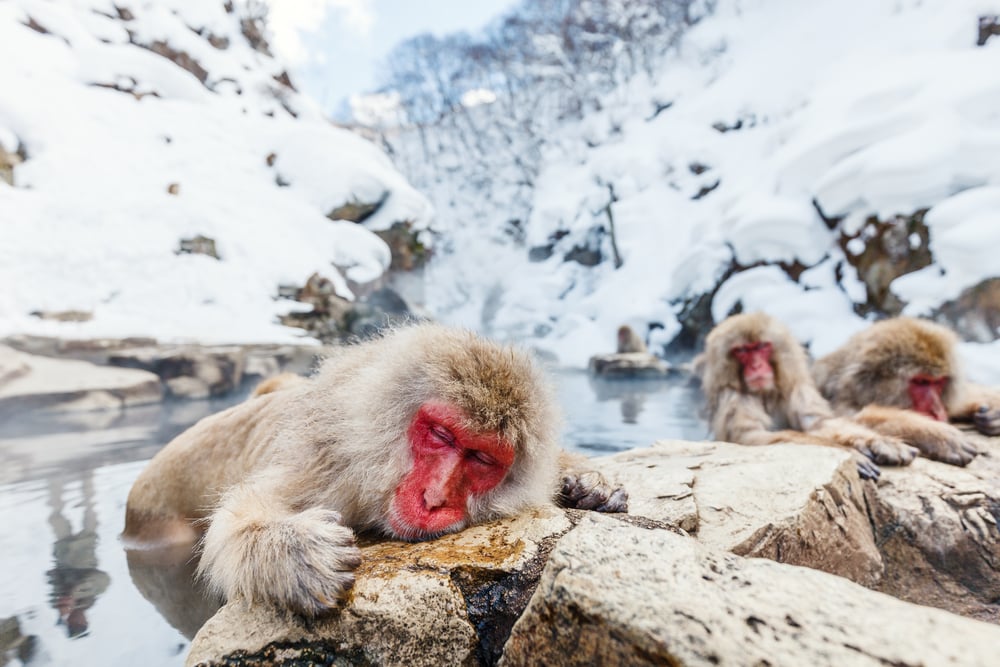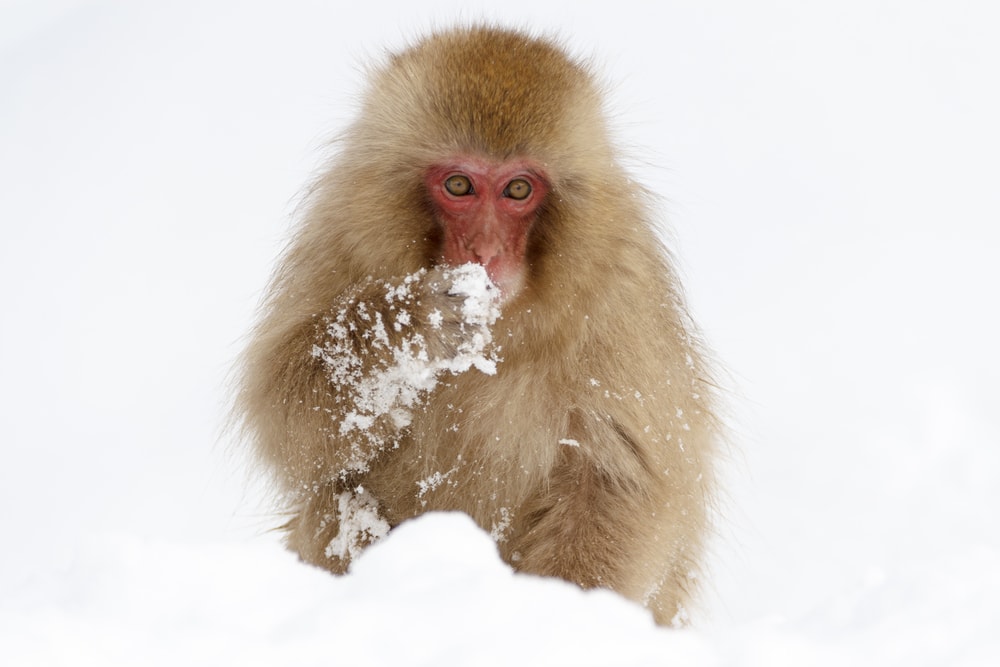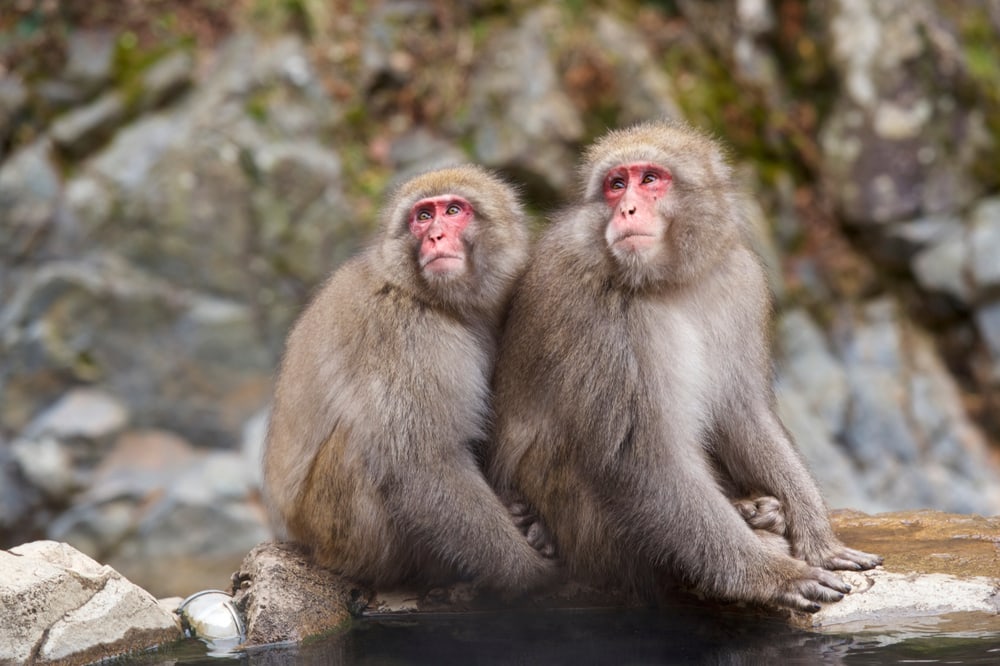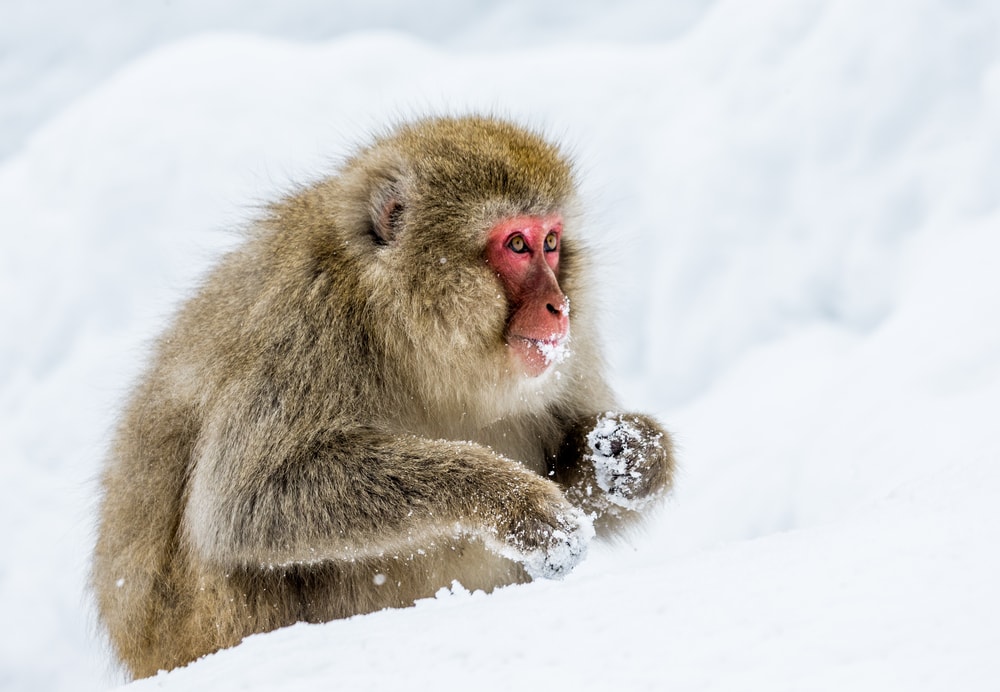Outforia Quicktake: Key Takeaways
- The snow monkey or Japanese macaque is a unique primate native to Japan, uniquely adapted to cold climates, making them the northernmost non-human primates.
- They’re known for their distinctive pink face and thick fur that varies in color from brown to greyish shades. This fur becomes denser in colder temperatures to combat harsh winters.
- They can be found in a variety of climates and are known for their bathing habits in hot springs, especially during winter.
- They live in groups called troops, with a strict hierarchy that influences various aspects of their societal structure.
- Their omnivorous diet changes with the seasons, showcasing their adaptability. They consume a variety of fruits, plant material, and insects, depending on the availability.
The snow monkey (Macaca fuscata), or Japanese macaque, is a fascinating primate native to Japan. These distinctive monkeys are known for their trademark reddish-brown face and adaptability to cold climates.
Japan is famous for this species, which have captivated scientists and tourists alike. But what is it about these primates that are so captivating?
Snow Monkey Appearance

The first thing you’ll notice about this species is its pinkish face, devoid of hair, providing a striking contrast to its coat.
Its fur varies in color from brown to greyish shades, providing some camouflage among the deciduous and coniferous forests that it calls home.
Their thick fur plays a crucial role in keeping them warm, particularly during the harsh winters in Japan. The density and plushness of their fur increase as the temperature drops, enabling them to withstand freezing conditions.
Its size also contributes to its ability to endure the cold; those living in colder regions tend to be heavier than their counterparts in warmer areas. Males usually weigh around 11.3 kg (25 lbs), while females typically weigh around 8.4 kg (19 lbs).
As you look at a snow monkey, you’ll see that this primate is sexually dimorphic, meaning males and females exhibit different physical traits.
These differences are not just limited to their size, but can also extend to their facial features and fur coloration.
Habitat and Geographic Range

These monkeys are native to Japan and can be found on the southern main islands of Honshu, Shikoku, and Kyushu, as well as a few smaller islands. They are known to thrive in a variety of climate zones.
In fact, they live further north than any other non-human primate, tolerating cold temperatures and snowy conditions for months each year.
During winter, you may find snow monkeys in areas such as Nagano Prefecture’s Jigokudani Monkey Park, where they famously relax in the park’s natural hot springs.
In contrast, during warmer periods, they may be seen inhabiting subtropical forests on the island of Yakushima and the Nikko area in the Kanto region.
Biomes
Japanese macaques have a preference for specific types of biomes within their geographic range. While they can survive in subarctic forests, they primarily inhabit subtropical and deciduous forests.
In central Japan, they have been spotted in warm forests, while in the southwestern regions of Honshu, as well as Kyushu and Shikoku, they prefer broadleaf evergreen forests.
In their selected habitats, snow monkeys largely depend on trees for access to food, shelter, and safety from predators.
These forests provide the necessary resources for them to thrive, allowing them to adapt to their environment and maintain their unique lifestyle as the world’s northernmost primates.
You May Also Like: How Strong Is A Gorilla? Discover The Astounding Power Of Our Primate Cousins
Snow Monkey Behavior

They use various forms of communication and perception to interact with one another.
For instance, grooming is a significant part of their social interactions, as it helps build bonds and maintain a stable group structure.
They also engage in facial expressions and various vocalizations, such as coos, alarm calls, and threat calls, to communicate within the group.
Snow monkeys also have a complex culture that is reinforced through learning from one another.
On Koshima Island, for example, they discovered a technique to clean sweet potatoes by washing them in seawater. This behavior, which is unique to their group, has been passed down through generations.
Home Range
They live in groups called troops, each of which has a dominance hierarchy. The dominant male holds a crucial role in maintaining order and leading the group.
Females occupy varying positions within this hierarchy, with daughters inheriting their mother’s rank. Being aware of their place in the hierarchy affects their interactions, traveling patterns, and access to resources within their home range.
As they navigate their environment, snow monkeys engage in activities such as swimming and bathing – most famously in the hot springs at Jigokudani.
These bathing behaviors serve as an adaptation to the cold climate, and also provide opportunities for social bonding.
Moreover, the monkeys’ home range plays a critical role in their ability to hunt and forage. Recent studies have shown that they achieve remarkable feats of survival by hunting fish in nearby streams during the winter.

Share This Image On Your Site
<a href="https://outforia.com/snow-monkey/"><img style="width:100%;" src="https://outforia.com/wp-content/uploads/2023/10/snow-monkey-infographics-10132023.jpg"></a><br>Snow Monkey Infographic by <a href="https://outforia.com">Outforia</a>Diet and Food Habits

Being omnivorous creatures, their diet changes depending on the season, and they are known for being excellent foragers.
In the warmer months, fruit is abundant in their natural habitat, providing them with a nutrient-rich and ideal food source.
They are known to enjoy the fleshy parts of a variety of fruits, like persimmons and apples, while leaving the seeds aside. Along with fruits, they consume a variety of plants, including leaves, seeds, berries, and sometimes even grass.
The summer season is truly a feast for these creatures, offering them plenty of options to choose from.
As the season shifts to winter, the availability of food decreases, and snow monkeys are forced to adapt their diet.
During this time, they consume bark and twigs to sustain themselves, showcasing their resourcefulness and adaptability when foraging. They also rely on whatever small amounts of fruits and berries they can find.
Apart from plant-based foods, they’re known to sometimes include more protein-rich options in their diet. These animals occasionally feed on insects and small invertebrates, adding more variety to their diet.
Reproduction Cycle and Lifespan of Snow Monkeys

The breeding season for this species typically occurs between September and April, when the temperatures begin to drop. During this time, the males compete to mate with the receptive females in their troop.
Once successfully mated, the gestation period for a pregnant female snow monkey is around 173 days, and they usually give birth between April and June, ensuring the new infants arrive when favorable conditions are available.
The new babies are born helpless and entirely dependent on their mothers for both warmth and nourishment.
The mother-infant bond is vital for survival, and the infants are carried by their mothers close to their chests, learning to cling to them from an early age. In the first months of their lives, they entirely rely on their mother’s milk for nutrition.
Weaning occurs when the infant starts to transition from its mother’s milk to solid foods. This process usually begins around the age of six months.
As the infant grows and develops, it starts to become more independent, exploring its surroundings and learning to gather food for itself.
However, the weaning process can continue until the infant is 18 months old, allowing it to develop vital skills that will help it thrive in the harsh conditions.
Lifespan of snow monkeys
Their lifespan can vary depending on its living conditions and overall health. In the wild, they can expect to live for approximately 6.3 to 32 years.
Their survival is also due in part to the complex society they live in, where rank and privilege play an essential role in determining access to resources and mating opportunities.
The Snow Monkey’s Role in the Ecosystem

An important aspect of snow monkey life is their interaction with trees. As agile climbers, they find refuge and safety in trees and form an essential part of the arboreal environment.
They feed on leaves, fruits, and seeds, and their feeding habits aid in the spreading of seeds to different areas. This helps with the propagation of various tree species, fostering forest growth, and supporting biodiversity.
They’re also fond of grooming. While grooming each other, they pick and consume insects from their fur. This foraging behavior promotes a healthy ecosystem by controlling insect populations.
Additionally, as they feed on insects, they help balance the food chain, benefiting other species that rely on these insects as a food source.
Their social nature, called matrilineality, also contributes to their environment. As highly intelligent animals, they’re quick learners and share their newfound skills and techniques with their troop.
This cultural transmission of knowledge allows them to adapt to their surroundings better, which in turn benefits their habitat as they learn to utilize resources more efficiently.
In contrast, their fishing habits also have an impact on the aquatic ecosystem.
In harsh winters, these resourceful primates scoop up live animals, such as brown trout, from rivers and consume them to stay alive. By doing so, they help maintain a balance in the population of these aquatic species.
Predation and Population Challenges

One of the monkeys’ predator is the sika deer, which share the same environment and can sometimes compete for resources.
Predation isn’t the only challenge Japanese macaques face. Environmental pressures and other factors contribute to a more significant concern for your survival as a species.
Population Threats
The current status of snow monkeys, like many other primate species, is worrisome. According to the IUCN Red List, over 60% of global primate species are listed as threatened. This assessment includes the Japanese macaques.
There are several major threats contributing to this decline in primate populations. These threats include:
- Habitat Loss: Rapid human expansion and industrial agriculture are causing extensive habitat loss in various regions, including your natural habitat in Japan.
- Climate Change: Monkeys are highly vulnerable to climate change, which could further endanger the species’ survival.
- Human-Wildlife Conflict: The construction of roads, dams, and other infrastructures in your habitat can lead to increased human-wildlife conflicts, jeopardizing their well-being.
Evolution of Snow Monkeys

These remarkable primates evolved to endure harsh winters and widely varied habitats, shaping them into the species we marvel at today.
It begins with the snow monkey’s ancestors, who are believed to have originated from the Korean peninsula 500,000 to 300,000 years ago, long before the first humans arrived.
As they migrated to Japan, they predominantly settled in the southern and western parts of the country. The monkeys adapted to their new environment over time and eventually spread throughout three of Japan’s four largest islands: Honshu, Kyushu, and Shikoku.
During their evolution, the monkeys developed characteristics that enabled them to survive in some of the planet’s coldest regions, where snow blankets the ground for several months each year.
In fact, no other non-human primate lives farther north or in a colder climate than these monkey species.
Adapting to hot springs
One of their most well-known adaptations is their fondness for soaking in warm onsen waters. These natural hot springs provide the monkeys with a refuge from the frigid temperatures.
Interestingly, this behavior began nearly 60 years ago, when the monkeys first ventured to the onsen at Jigokudani.
Social adaptations
These primates live in complex societies with strict hierarchies that determine their rank and privilege. Members of the troop are acutely aware of their place within the dynamic structure.
This intricate social structure has proven essential for the snow monkey’s survival, allowing them to cooperate effectively when facing challenges posed by their environment.
You May Also Like: The Remarkable World Of 18 Cold Blooded Animals: From Sharks To Scorpions
Human-Snow Monkey Interactions

Visiting the Jigokudani Monkey Park in Japan, you might be able to observe them soaking in hot springs. This unique behavior has attracted tourists from all over the world and boosted the local economy.
Tourism to the monkey park and surrounding regions benefits from this natural spectacle, with visitors eager to glimpse these remarkable creatures in their natural habitat.
Japan’s high-speed railways, such as the Hokuriku Shinkansen, make it convenient for tourists to travel between Tokyo, Kyoto, and Osaka, with easy connections to airports and other attractions.
Many visitors to Japan make a stop at the Jigokudani Monkey Park, enjoying a truly unique experience that cannot be replicated in traditional zoos.
Tourism generated by snow monkeys not only contributes to local business growth but also creates a global appreciation for these animals and their environment.
The Negative Economic Impact for Humans
However, the interaction between these monkeys and humans is not all positive. In some cases, the species can cause damage to crops and property, leading to economic losses for local residents.
For instance, as these monkeys seek food and explore their surroundings, they may venture into farmland or residential areas, damaging crops, and causing a nuisance for locals.
Furthermore, the presence of human tourists might disrupt the natural behavior of snow monkeys and potentially lead to conflict between humans and these animals.
Conservation Status of Snow Monkeys

Japanese macaques are not currently classified as an endangered species. Nevertheless, it is essential to keep monitoring their population and habitat to ensure their long-term survival.
Human activities, such as deforestation and land development, significantly impact the monkeys’ natural habitats. To address this issue, local and international organizations are working together to implement conservation strategies.
Habitat conservation
One of the main approaches to protecting them is preserving their natural habitats. Conservation efforts include establishing protected areas where human presence is limited, and land use regulations are enforced.
By controlling human activity in these regions, snow monkeys have a safe space to thrive, ensuring the survival of their populations.
Tourism
Another critical aspect of their conservation is raising public awareness and promoting eco-tourism.
Many nature enthusiasts and tourists are drawn to visit monkey habitats in Japan, which can provide economic incentives for local communities to engage in sustainable practices and protect the environment.
By supporting eco-tourism initiatives, you are indirectly contributing to conservation efforts and ensuring a better future for these amazing animals.
Research
Research also plays a vital role in understanding their needs and conservation requirements.
Scientists continuously study the behavior, habitat, and population dynamics of these primates, providing valuable data to inform conservation policies and actions.
By maintaining a consistent research presence, experts can closely monitor the snow monkey populations and propose targeted strategies to address any emerging threats.
Interesting Facts and Features about Snow Monkeys

Snow monkeys are well-adapted to the freezing cold.
They live in the northern regions of Japan, where they brave freezing temperatures and snowy landscapes.
These amazing primates have adapted to harsh climates and can survive temperatures as low as -20 degrees Celsius. They are the only primates, besides humans, to live so far north.
Snow monkeys love hot springs.
One of the most iconic aspects of their behavior is their love for hot springs, or onsens. During the winter, they frequently visit these natural sources of warmth to bathe and relax.
The Jigokudani Yaen-Koen, located near Shiga Kogen, is a famous park where these monkeys can be observed bathing in onsens.
Snow monkeys can dig and swim for food.
In addition to warmth, these resourceful monkeys seek out food and water in their snowy environment. Japanese macaques have a diverse diet, ranging from fruits and leaves to insects and small mammals.
When food is scarce, they have been known to dig through snow to find buried plants or use their skills as excellent swimmers to fish in nearby bodies of water.
Grooming is an important activity for snow monkeys.
Grooming plays an essential role in snow monkey society. They spend a significant amount of time grooming each other, not only to maintain cleanliness, but also to strengthen social bonds.
In fact, their complex social structure can be observed through these grooming rituals, as they often groom those who are higher in rank.
Snow monkeys are self-aware.
Furthermore, they have demonstrated a remarkable trait – they can recognize themselves in a mirror. This indicates a level of self-awareness and intelligence rarely found in other primates.
So next time you see photos or videos of these fascinating creatures, remember: there’s more to them than just their adorable appearances.
You May Also Like: Are Foxes Canines Or Felines? The Untold Story Of These Cunning Creatures
Snow Monkey Frequently Asked Questions

What is the best time to visit Jigokudani Monkey Park?
The best time to visit Jigokudani Monkey Park is during the winter months, from December to March. During this time, you can witness them soaking in the hot springs, which is an amazing sight.
How do snow monkeys adapt to cold environments?
They have thick fur that keeps them warm and helps them survive in the colder regions of Japan. Additionally, they are excellent swimmers, allowing them to access hot spring pools to stay warm during the freezing winter months.
Can you interact with snow monkeys in Japan?
While observing them from a close distance is possible, it is essential to maintain a respectful distance and avoid direct interaction.
Touching or feeding the monkeys is not allowed, as it may cause harm to both the animals and yourself. Remember to follow the guidelines provided by the parks and sanctuaries to ensure a safe and enjoyable experience for all visitors.
Are snow monkeys found in other countries?
They’re native to Japan and are not found in other countries. They primarily inhabit northern Japan and are well-adapted to the cold climates in the region.
The Yakushima macaque, a subspecies of the Japanese macaque, can be found specifically on Yakushima Island.
What is the significance of the Nagano Snow Monkey Park live stream?
The Nagano Snow Monkey Park live stream allows people from around the world to watch the snow monkeys in their natural habitat.
The live stream provides a unique opportunity to observe the monkeys live and understand their behavior without physically being there.









